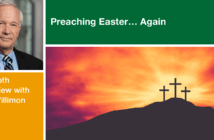Early in my own ministry, I always found stewardship season anxiety-producing. While I got better at it, I still found the fall campaign difficult. One year the program we were using strongly suggested the pastor make his or her pledge public as part of the stewardship sermon. In our congregation, there was a lot of anxiety about the confidentiality of giving records. But I realized that no one could say I couldn’t reveal my own secret.
When clergy and lay leaders are in partnership, and are all able to share clearly why they give to the church, it creates a powerful message to the congregation.
At the end of my sermon, I got out my pledge card. I said, “My pledge this year will be X dollars,” and I filled it in right at the pulpit. People gasped. As someone who tithed, I was one of the bigger givers in the church — and no one knew it. One woman told me later she crossed out the number on her card and filled in a larger one. Pledges did go up significantly that year. And more important, it got me freer about money. I had defined myself, in public to them, about something that was very important to me. One secret had been told. I continued to talk about my own giving every year as long as I was there, and giving continued to go up. I felt less anxious about the entire process from that time forward.
Testifying is one of the best ways to lead. It is self-definition. Telling your own story is far more powerful than telling others what they should do. This approach is more than a stewardship technique. It is a way to show up as more present in this process of speaking to others about giving. You don’t have to be a perfect example for your story to have power to others. Joe Clifford of First Presbyterian Church of Dallas tells about sharing his own giving story in a stewardship-oriented sermon:
I talked about a time in my life when I was giving $500 to the church. I felt like I was doing pretty well: I’d never given $500 a year to anything in my life. But I realized I was giving one percent of what I was earning and that really wasn’t a big deal. We got on the journey toward tithing. We couldn’t start at ten percent but we started at two percent and we worked our way up, and over time we got to ten percent. I was very honest about the fact that we set a personal goal to be at a tithe, but there are years we make it and years we don’t. I had so many people who came to me and said, “Thank you so much for being that honest.”
People respect candid leadership, especially around something as challenging as making giving decisions.
Consider sharing some of your own family story as part of stewardship sermons. Another Presbyterian pastor, Jonathan Eric Carroll, suggests that it can be enlightening for others to hear the preacher reflect on his or her own family. You might share how your family handles issues of money and stewardship, and who you are becoming in light of those family dynamics, in addition to reflecting on the biblical text.
Of course, telling the story is not simply up to the pastors. Key lay leaders must be involved and willing to say boldly, “Here’s what I think is important about our church and about giving and why.” Clergy can coach lay leaders to define themselves around why they give to the church, to tell their own story in a compelling way. The best stewardship testimonies can make the sermon that Sunday seem almost unnecessary. When clergy and lay leaders are in partnership, and are all able to share clearly why they give to the church, it creates a powerful message to the congregation.
This article is excerpted from Margaret’s recent book Money and Your Ministry (2014) and used with the author’s permission. The book is available at https://margaretmarcuson.com or Amazon.
Related Resources:
- Give a Word of Witness by Kristine Miller and Scott McKenzie






